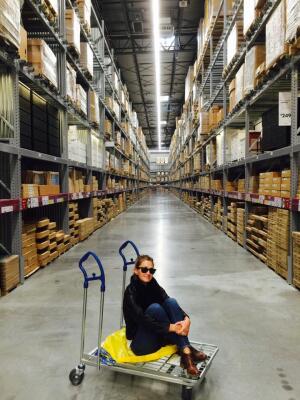Ikea-n't Believe How Much Work This Is
 On Sunday, I Ikea-d for the first time. Have you ever been to Ikea?
On Sunday, I Ikea-d for the first time. Have you ever been to Ikea?
Picture JFK airport chockfull of travelers dragging luggage and carrying backpacks. Now picture the airport as a giant grocery store. The travelers are now shoppers, and their luggage and backpacks are now carts and baskets. Now imagine all the food in the grocery store—on the shelves and in the carts in a building the size of JFK—slowly turning into furniture and household appliances. And imagine that it is back-to-school season. And Christmas. And lunchtime. All at once. And imagine that this is the last store on earth. And that Pitbull is there for no reason.
Now you know what Ikea is like.
It was Tom’s idea—to go to Ikea, not Ikea itself. He wanted me to behold the Ikea experience. (He also wanted a bedside table for less than sixty bucks.) So we fueled up with giant iced coffees, hopped in Ron, Tom’s full-size (burgundy) van, and headed to midtown. We found a parking spot near the product return elevators, which was impressive for two reasons: 1) we found a parking spot at all and 2) there are designated elevators for product return. We hopped on the escalator and rode to the first floor, where Tom grabbed a giant yellow shopping bag and announced to the man standing next to the store brochures, “Will you explain to her how Ikea works? She’s never been to an Ikea before.”
The Man in the Yellow Shirt (not to be confused with a character of the same name from Curious George) was happy to oblige. He clarified that the brochures were not really brochures, but product cards on which we would write the item codes for any products we wanted. He pointed to what looked like a subway map if a subway had only one track.
“This part is all displays. And over here—” he flung his hand down the line past several stops, including “Textiles,” “Wireless Charging,” and “Restaurant”—“is our self-service warehouse.”
Let me just say that if someone ever says the words “self-service” and “warehouse” in a single sentence, you’ve probably got some heavy lifting in your future.
After our heart-to-heart with The Man in the Yellow Shirt, we jumped onto another escalator, which carried us into the Land of Displays, a city of geometric furniture and lighting fixtures inspired by Bjork’s wardrobe. Items with names that sounded like titles to Sigur Ros songs—Vika Annefors and Ljuvlig—beckoned with sleek, assembly-required styling, like big, fancy Legos. It was simultaneously awe-inspiring and dreadful.
We were herded from one room to the next, nudged and jostled along by a mass of humanity and shopping carts. But we continued our pilgrimage, and Tom even managed to find his bedside table for sixty dollars. Breezing through “Kitchen Appliances” and completely bypassing the bottleneck at the restaurant, we made our way to the self-service warehouse, which I am still not convinced isn’t just a Home Depot. Using what I believe to be the Swedish version of the Dewey Decimal System, Tom navigated the pushcart down the cathedral aisles to the appointed nightstand, and then to the checkout lanes, which stretched the length of a football field (give or take a down).
And there was a DJ. I don’t know why.
“So now you’ve been to Ikea!” Tom said as we tossed the future bedside tables into Ron. “What’d you think?”
“Man, those Swedes sure know how to make cheap furniture,” I said, “and fish.”
For years I had heard about Ikea. The place is basically the Oz of furniture. I mean, I had friends who roadtripped to Chicago—U-Hauls hitched to their SUVs—just to go to shopping there. It’s like its own subculture of fanatics. It’s like its own little universe.
It's like running.
There’s no instant gratification at Ikea, just like there’s no instant gratification in running. In running, Fartlek is a form of speedwork. At Ikea, Fartlek is a couch. Fitness won’t last forever without great care and upkeep. Neither will that forty-dollar coffee table. The longest lines are always in front of the food and the bathrooms. And only at an Ikea or a marathon will you witness such a large and diverse group of people struggling in a common enterprise. Because some things transcend age, gender, ethnicity, nationality, religion, and even political beliefs.
And those things are free bagels and a cheap bedroom set.
Still, I’m surprised Ikea is so popular. I mean, you fill out a form and pay money just so you can do a bunch of work, most of which will occupy your weekends.
I mean, who would do that, right?

Amy L. Marxkors is the author of The Lola Papers: Marathons, Misadventures, and How I Became a Serious Runner and Powered By Hope: The Teri Griege Story. Click here to receive Amy's weekly article via email.
Connect With Us
see the latest from Fleet Feet St. Louis